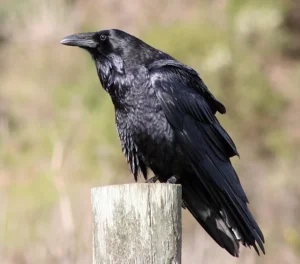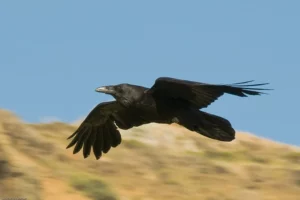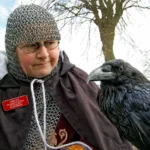Ravens are the largest all-black passerine bird. Although cosmopolitan, common ravens are mostly found abundantly all across the Northern Hemisphere.
To get to know the bird better, you must first learn its basic characteristics. So, here is a list of all the characteristics of the raven, a fascinating all-black bird.
| Subspecies | 8 subspecies |
| Physical features | Large Mostly entirely black Thick neck Shaggy throat feathers Large feet Long bills Slender wings Wedged-shaped tail |
| Size | 22 to 27 inches |
| Weight | 1 to 3.5 pounds |
| Wingspan | 45.5 to 46.5 inches |
| Plumage color | Typically solid black, except for some subspecies like white ravens and white-necked ravens |
| Eye color | Varying colors from dark brown to gray and pure white |
| Fly capability | Great |
| Vocalization | Over 30 different vocalizations |
| Intelligence | High |
| Eating habit | Omnivorous |
| Social structure | Mostly seen in couples. But in winter they form groups |
| Social behavior | Less social than crows |
| Playfulness | Yes, high |
| Friendliness | Capable |
| Nesting | Build nests in high places like cliffs, billboards, trees, telephone poles, bridges, and other places |
| Aggression | Depends on the situation but are not overtly aggressive |
| Habitat | Wide and include woodlands, forests, rocky coasts, etc. |
| Lifespan | 10-15 years in the wild Over 40 years in captivity |
Let’s concentrate on the traits of ravens in more depth.
Subspecies
Most experts assert that there are 8 subspecies of ravens. However, deviating from this perception, some ornithologists claim that 11 subspecies of ravens could be found.
Physical features
Ravens lack any marks and are typically all-black. White ravens and white-necked ravens are the exceptions, though. These birds are also distinguished by their large, powerful beak, fluffy neck feathers, and wedge-shaped tails. Additionally, ravens’ feathers are primarily curled.
Size and Weight

Ravens vary in size and weight depending on their subspecies. However, ravens are commonly considered of as large birds. Typically, they are 22 to 27 inches in size. With a wingspan of between 45.5 and 46.5 inches, ravens can weigh between 1 and 3.5 pounds.
Plumage color
Ravens have dark, polished, and rich black plumage that shines with a bluish or purplish gloss under the light. Also, these birds have feathers that are a light gray color on their necks.
Eye color
Ravens can have eyes that are pure white, dark brown, or blue. The iris of a common raven is dark brown, whereas those of its young are bluish-gray. On the other hand, the irises of the Australian raven species are entirely white.
Flying capability

Ravens are accomplished flyers. In fact, it almost appears the bird is having fun using its wings. Ravens leap higher than crows as well but slower than the latter. Ravens can fly at a typical speed of 25 miles per hour. This bird can even fly upside down, which makes it stand out the most.
Vocalization
There are many calls that Common Ravens can produce, from a loud “caw” to a deep, gurgling croak. It is also amazing that scientists have used over 30 categories to categorize raven vocalization. The majority of vocalizations are made for social purposes.
Intelligence
Ravens are incredibly smart birds. In reality, studies conducted by experts have revealed that ravens are on par with chimpanzees and orangutans in terms of intelligence. Scientific Reports claims that their intelligence is extraordinary over a wide spectrum of cognitive abilities.
Eating habits
The raven is an omnivorous bird. Although they prefer to eat dead animals, they will also take live ones. They also include fruits and vegetables in their menu.
Social structure
Ravens spend the majority of the year in pairs and are primarily monogamous. Furthermore, ravens like to gather in groups to feed and roost during the winter.
Social behavior
Compared to crows, ravens are less sociable. Yet, these birds can form a strong bond with humans if they are treated well.
Playfulness
One of the playfulness and mischief-loving wild birds is the raven. In fact, these birds have a reputation for pouncing on and pestering animals like dogs and cats by grabbing their tails or ears. They even enjoy tearing off pieces of twigs to pretend swordplay.
Friendliness
Ravens are smart birds. They can recall both positive and bad faces that have interacted with them. So, if given a welcoming environment, ravens can show their amiable side.
Nesting
Ravens often build their nests on higher ground, such as cliffs, trees, and structures such as telephone poles, banners, bridges, and electricity towers. They also return to the same nest year after year.
Aggression
Ravens are not a particularly violent bird species. However, they can easily display their aggressive side without hesitation if they feel threatened.
Habitat
Ravens are usually found in the northern hemisphere. They can be seen in various settings, though they favor open or somewhat open areas.
Lifespan
Ravens can survive for 10 to 15 years in the outdoors. These birds, however, could live to be 40 or 50 years old in captivity.
Characteristics of Australian ravens

Most of southern and northeastern Australia is home to the Australian raven, also known as Corvus coronoides. Here, we’ll outline the fundamental traits of Australian ravens.
| Scientific name | Corvus coronoides |
| Subspecies | 2- C. c. coronoides and C. c. perplexus |
| Habitat | Variable, other than in the drier regions of Western Australia |
| Size | 18–21 inches long39 inches wingspan |
| Weight | Around 1.43 lb |
| Physical appearance | All black body White-eyes (adults) Dark eyes (young birds) Longer feathers near the neck Black beak Gray-black legs and feet No flapping of the wings when calling A pink, fleshy gape (young bird) |
| Plumage | Black with a blue-purple to a blue-green sheen |
| Intelligence | High |
| Distribution | Mostly in eastern, southern, and central Australia |
| Diet | Mainly carnivorous. But also feed on grains, fruits, and vegetables. |
| Vocalization | A slow, high ah-ah-aaaaah call, with the last note, dragged out. |
| Behavior | Typically sedentary |
| Nests | Large and untidy |
| Minimum breeding age | 3 years old |
| Breeding season | July to September |
Summary
So that was our take on ravens’ essential traits. Ravens are wild birds, and capturing and keeping them as pets is illegal unless you have specific authorization. These intelligent birds are primarily found in the northern hemisphere.



